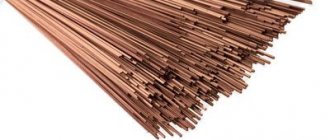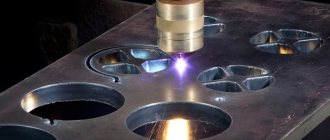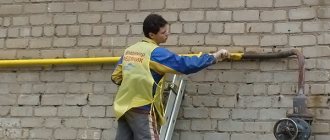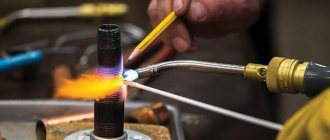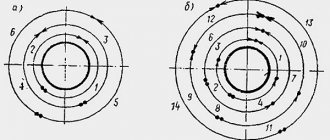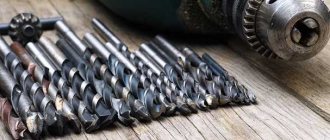The use of [metal pipes] in the production and installation of metal structures involves the need for cutting across, along and at an angle. And you don’t always have special equipment at hand. We will describe in this article how to cut a pipe evenly using available tools.
Cutting pipe at an angle of 45 and 90 degrees
If you need to cut a pipe at an angle of 45 degrees, which is often required when laying water and heating pipes.
Often steel and cast iron pipes that have a cylindrical shape are used. In installation work, rectangular or profile pipes are used. However, you should cut the pipe correctly with a grinder so that you can easily connect it later. Therefore, you should carefully mark the pipe. Some craftsmen try to mark the cutting area using a tape measure, but we warn you that the result will most likely be negative. And for a positive result, consider the following recommendation from professionals.
Take a sheet of paper or cardboard, preferably A4, fold it diagonally and wrap it around the pipe where you plan to make an even cut. The edges of the paper must be absolutely aligned with each other. And the side of the paper that is closer to the end of the pipe was perpendicular to the axis. Then mark a cutting line in a circle.
If you need to cut exactly at an angle of 90 degrees, then solve the problem quickly using paper or masking tape. Wrap it around the pipe so that the ends match. Make an even mark and saw off.
How to cut a profile pipe evenly?
Craftsmen advise using a square when cutting a profile pipe. To do this, apply the square to the sides one by one, and turn and apply marks with smooth movements. After the steps, secure the pipe and cut. Prepare yourself a template that will be useful in the future and will save time. It is better to carry out the action with a grinder, so the cut will be smoother.
How to cut a cast iron pipe?
When working with cast iron pipe, keep in mind that it is a fragile material. Therefore, we will find a way to cut such metal without damage.
Before starting work, make notes for the cut, as you would when working with steel pipes. Place a wooden beam for support. Run a grinder around the circumference of the pipe, making small cuts. Then take the chisels, insert them into the groove and hit them hard with a hammer. Please note that Bakelite-based cutting discs are used to cut cast iron pipes.
If you don’t have a grinder at hand to cut a cast-iron sewer pipe or other purposes, use a hacksaw, chisels or special pipe cutters.
How to cut a gas pipe?
Cutting a gas pipe is a dangerous action, so it is best to leave it to professionals. But if you are confident in your abilities, then use a grinder, welding, hacksaw, or gas welding to cut metal.
Trimming instructions:
- Before work, turn off the gas supply riser. Then release the rest of the gas from the pipe. To do this, light the gas in the burners and wait for it to go out.
- After these steps, cut. Using a welding method, the metal base burns when exposed to high temperature. The result is fast and effective. But remember that cutting or rooting gas pipes again requires experience.
Methods for cutting large diameter pipes
For cutting large diameter pipes, such as sewer pipes, there are a number of reliable tools available. Next, let's look at some of them in detail:
The grinder is an inexpensive and accessible option, but it is considered not the safest when working with such materials. If you decide to use this method, be careful and use protective equipment. A roller machine (pipe cutter) is a tool adapted for such manipulations. The device is attached and material removal begins. The clamping force is adjusted using mechanical devices
It is important to note that machine models differ in shape, so before use, consider the size relationship with the pipe. Gas cutting is the most popular option for cutting larger diameter pipes and sheet metal. The cut occurs due to the action of a high intensity flame, the metal melts and leaves the cut area with a gas flow
This method is convenient and effective.
How to cut a pipe lengthwise correctly?
A quick way to cut a pipe lengthwise using a grinder:
Pay main attention to the markings. For this case, use painting thread, which is widely used when marking walls.
Before starting work, secure the pipe and, using small movements, carefully saw the pipe. It’s better not to rush, but delicately and slowly process the parts of the pipe, so that the cutting disc does not jump off the marking lines. Remember safety precautions.
How to cut thin-walled pipes?
Thin-walled pipes are made of non-ferrous metals: aluminum, copper. Such work should be done delicately, as there is a high probability of deformation of the material. For cutting, fillers such as sand are used. Actions can be carried out using a grinder or a special machine.
We measure
The first method is not entirely convenient, but quite accurate. Suitable if you are “in the tundra” and have nothing at hand except a pencil and tape measure. I had to use it a couple of times. The diameter of the pipes does not matter.
An important condition is the presence of a flat plane near the cut. This could be the edge of a pipe, a socket, a put-on or welded-on coupling, a seam, or any other concentric circle.
We mark the place of the cut with a risk. We measure the distance from the mark to a flat plane. We rearrange the tape measure along it and make risks in a circle, using the given size. We get a circle from the marks.
45 degree cutting
But, if you still need to cut a round pipe made of steel or various types of plastics, then for this you will need a pattern for cutting pipes at an angle, the shape of which is calculated manually or by machine. The task is greatly simplified if it is necessary to cut a square metal profile at an angle of forty-five degrees.
For quick cutting, you can use a regular sheet of paper folded diagonally to mark the surface for future cutting. When using folded paper, proceed as follows:
- carry out on a straight surface of the profile in the place where the cut is made, strictly perpendicular to the line;
- apply a sheet of paper folded diagonally to the side surface with the sharp end to the line so that the upper edge of the paper triangle is flush with the top side of the metal profile.
Rice. 2 Homemade template for cutting pipes at 45 degrees
draw a line with a pencil along the side of the sheet at an angle of 45 degrees, after which the paper corner is applied to the other side and traced with a pencil (it is better to use a thin marker).
For sawing, you can use a grinder with a metal disc, first drawing a thin line along the marking, and then gradually deepening it until the edges are completely separated.
Making a template for cutting metal profiles
If you need to cut a large number of pipes, you can make a template from a metal profile of a larger diameter using a paper sheet using the above method. The angle of inclination is checked with a protractor or a construction square - in this case, the two edges of the cut parts of the template are connected.
When working, a template is placed on the part to be cut in the right place and pressed tightly, the markings are applied with a sharply sharpened scriber while tracing the template outline. The part is cut in several passes with a gradual deepening of the groove.
Rice. 3 Cutting a metal profile using a miter box
DIY miter box for cutting pipes
Using a template is not very convenient - you have to make a cut along the line, holding the grinder in weight, which leads to large errors. If you have a welding machine, you can make a simple miter box - guides for the grinder disk, preventing it from moving to the side.
To do this, use a previously made template, drill a hole in the side of which and weld a nut. When working, a homemade miter box is placed on the profile, a bolt is screwed into its nut and the device is pressed against the profile surface. A grinder with a metal disc is used to make a cut, lightly pressing the disc against the side surface of the device. It is clear that with prolonged use, the edges in the miter box are gradually ground down, and although the process occurs simultaneously on all edges, some errors will appear over time. Therefore, it is better to make the device from hard, wear-resistant metal in order to increase its service life and obtain a more accurate instrument.
Fig.4 Example of making a cut at an angle of 90 degrees
Another similar option
You can do it differently. First, the same work is done as in the previous version - a strip is drawn, a corner is laid and pressed. But here the groove is made somewhat deeper - 4-5 mm. After the corner is removed, the remaining metal can simply be broken off, and the edge can be processed using an angle grinder with a grinding disc. However, there may be small pits on the edge, which makes the second option more acceptable.
The groove along the guide angle is made a little deeper than in the previous version
Changing the configuration of pipes made of non-ferrous metals
Non-ferrous metals have a very useful property - high ductility. However, they are not strong enough. During the bending process, as a result of the application of compression and tension forces, the pipe may collapse or rupture. To prevent this from happening, you must strictly follow the technology.
How to bend copper and brass pipes?
Both hot and cold methods are used for bending copper and brass pipes. When choosing the first, sand is chosen as the internal filler, and molten rosin is used as the second filler. The bending technology is the same as for steel pipes.
Tubular products made of copper and brass are subject to annealing and subsequent cooling before cold bending. The temperature range for both materials is the same - from 600 to 700⁰С. The difference is in the cooling medium - copper is placed in water, and brass is cooled in air.
Once the process is complete, the rosin is removed by smelting it. To prevent pipe rupture, the process should never be started from the middle of the pipe, only from the ends. Both simple tools and complex machine equipment are used as bending devices.
Manual pipe benders work due to human physical efforts, while hydraulic ones reduce these efforts to a minimum. Both are equipped with interchangeable nozzles to allow you to select the desired diameter.
The minimum radius for bending copper and brass pipes is regulated by GOST 617-90 and GOST 494-90, respectively. Experts do not recommend using this radius unless absolutely necessary. It's always better to use a larger value
It is much easier to work with copper and brass pipes than with steel ones, but metal deformation during bending occurs according to the same laws of physics. In the bending section, the outer surface experiences tension, as a result of which the walls become thinner.
Inside the pipe, reverse processes occur - the wall shrinks and becomes thicker. There is a risk of the round section turning into an oval and reducing the nominal diameter, so bending should not be started without taking measures to prevent these phenomena.
Aluminum pipe bending
The main methods for bending aluminum pipes are the same as for brass or copper:
- pushing between rollers;
- rolling;
- rollback;
- pressure.
Before making a decision about how and in what way to bend aluminum pipes, you need to familiarize yourself with each one. The first method is used for thin-walled pipes with a maximum diameter of 10 cm, when it is necessary to obtain a gentle bend with low accuracy requirements. The minimum radius is strictly regulated here. Its size is 5-6 pipe diameters.
The curvature of the section is determined by the position of the deflection roller. Interior decorative elements are most often made in this way. The second method is to bend large-diameter pipe material, for which 3-roller pipe benders are used. The pipe is pulled between drive rollers, the orientation of which determines the bending radius.
The photo shows a stationary electric 3-roller pipe bender, but there are also manual mobile models of the equipment. On it, the workpiece moves through rollers and is bent at a given angle along its entire length. On such a machine, you can change the configuration of the pipe by bending it into a ring, a spiral, or making an arc of large radius
The accuracy of this method is even lower than the previous one, but the part can be re-bent and the process repeated until the desired geometry is achieved.
Bending aluminum thin-walled pipes can be done manually with proper preparation:
The rolling method does not provide for the presence of internal filler, so it is not used to obtain small radii. When choosing this method, it will not be possible to fulfill the strict requirements regarding the ovality of the section at the bend.
To deform an aluminum pipe by pressure, presses are used with stamps installed on them with a matrix of the desired shape. The given geometry is obtained as a result of the influence of pressure exerted from the outside.
In some cases, the pressure can be internal, when the pipe is placed in a mold and liquid is supplied inside with a pressure sufficient to press it against the walls.
It is not easy to bend duralumin pipes, because... This material is quite hard and springy. To facilitate the process, they are fired immediately before bending at a temperature of 350 to 400⁰C, then wait until the pipes cool naturally in the air.
Pipe cutter for steel pipes
When using steel pipes of different diameters, craftsmen often encounter difficulties during fitting and cutting. A specially made pipe cutter is best suited in this case. Before purchasing a tool, it is advisable to study the nuances of all varieties of such ready-made devices.
The first thing you need to pay attention to is the diameter of the pipe and the material for which the tool should be cut. There are three types of cutters:
There are three types of cutters:
- for thin-walled pipes;
- for ceramics;
- for very large volumes of work.
It is important to note that only electric cutters are designed for heavy loads. The operation of such tools is almost completely automated
They can cut pipes made of cast iron or steel with a diameter of up to three hundred millimeters.
Let's look at the main professional cutting mechanisms, which differ in their features and design.
- A roller pipe cutter is used for cutting steel products. The design of this tool includes groups of rollers. Some carry out the actual cutting of the material, while others are designed to guide the pipe during operation. A roller pipe cutter, which has one roller in its design, can cut products up to fifty millimeters in size.
- A pipe cutter can be used to cut plastic pipes with a diameter of up to one hundred millimeters. This cutter looks like a steel holder with discs that are adjustable to the desired diameter. The incision itself is made with the same discs.
- Chain pipe cutter. This tool is used very rarely, because it is intended exclusively for cutting fragile ceramics or concrete.
Pipe cutters are also divided into manual, electric, hydraulic and pneumatic.
- The manual pipe cutter is easy to use. To make a cut with this tool, you need to fix the device on the pipe in the right place and make several turns with the handle or the pipe cutter itself. One of the main advantages of manual cutting equipment is easy control of the entire process, since the cut is obtained as a result of the application of physical forces that you regulate. The disadvantages of such cutters are the physical fatigue of the master during a large volume of work and the small diameter of the pipes being cut.
- Using an electric cutter, you can complete large jobs in a fairly short time. The advantage of such a cutter is the very high quality of the materials used in its production. The strength of this tool will allow you to perform numerous cutting operations repeatedly without worrying about the wear resistance of the tool. One of the advantages of such a device is the ease of cutting performed by an electric motor. There is practically only one downside to such a tool - the high cost of the cutter. Therefore, such a purchase for one-time work is impractical.
A milling machine is also used for cutting pipes. Waterjet cutting is one of the fastest and most effective methods. Metal processing is carried out by a jet of liquid that comes out of a special nozzle at high speed and pressure.
straight cut
An even cut at an angle of 90º can be made only after marking has been applied. Use writing paper or masking tape. The latter is preferable, because it is attached directly to the surface and does NOT move.
READ Photoelectric Pipe Cutting Saw
The sequence of actions looks like this:
- Using a tape measure, measure a piece of the required length, mark this place with a line with a marker.
- Next, stick tape along the resulting mark around the circumference of the pipe. The smoother you apply the adhesive tape, the better - it is optimal that the wide edges meet as accurately as possible. This will allow you to make an accurate cut of the pipe according to the mark.
- The next step is to secure the pipe in a vice or press it to a flat plane so that it does not move during work, and an even seam is obtained. Note that one end of the pipe must be left in a free position so that during the cutting process the disk is NOT pinched by the walls. Cutting starts from top to bottom.
- The last thing you need to watch is how to cut the pipe evenly with a grinder. To do this, you need to guide the disc as accurately as possible along the edge of the adhesive tape.
In cases where tubular products with large sections are being cut, the work must be done in small sectors. To do this, the pipe will have to be constantly rotated around its axis after completing the next cut.
When working with cast iron pipes, the scheme of actions will be slightly different. First, a continuous cut is made along the entire diameter of the product, then, using a chisel and a hammer, the resulting groove is gradually tapped, as a result of which the pipe should split strictly along the cutting line of the cut.
How to cut a pipe straight along
» Miscellaneous » How to cut a pipe straight along
In households, profile pipes are widely used in the manufacture of greenhouses, greenhouses, canopies to protect vehicles from precipitation and other structures. When working with this material, it is useful to know how to cut a profile pipe along a line or crosswise with the most accurate angle.
Among the large number of construction metal cutting tools, the leader in speed, ease of cutting and efficiency is the angle grinder (grinder), which is often present in the tool kit of any home craftsman. To cut a profile steel pipe using a grinder, you will need a regular metal disc and strict adherence to safety rules - breaking the disc into segments at high rotation speeds can lead to serious injuries.
Fig.1 Profile pipes in the household
Features of working with an angle grinder
Safety precautions when working on a drilling machine
A modern angle grinder allows you to replace the emery when working on metal. To avoid problems, it is useful to remember a few guidelines when using the tool:
- The angle grinder should be held with both hands during operation. In the event of a kickback, a strong fixation will minimize displacement. Otherwise, the risk of injury increases.
- Work should be carried out on a flat surface, confidently maintaining balance.
- Place the power cord on the opposite side of the disk. The operating instructions for the angle grinder make these requirements in order to avoid short circuits and shock waves from the unit.
- When completing work, the tool should be held firmly in your hands until the disk comes to a complete stop.
- If there is a power outage, you must unplug the tool from the outlet. Otherwise, the angle grinder may start working without operator control.
- The work process is accompanied by heating of the disks. After turning off the tool, they should not be touched until they cool down.
Fixing the material
General recommendations from experts
Bulgarian
The use of an angle grinder is a very popular mechanical method, which is used both at home and in production.
Cutting with a grinder requires maximum caution from the master. Care should be taken to protect hands and eyes with gloves and goggles.
It is also important to adhere to the following rules:
work with an angle grinder must be carried out by a master who has experience in handling this tool; It is important to secure the equipment firmly; You cannot process concrete or stone with a disc that was originally designed to cut metal; in order to avoid the disk “popping out”, you need to control the direction of movement of the grinder, it must coincide with the direction of rotation of the disk; The tool must be covered with a protective casing, otherwise work cannot be carried out.
Roller pipe cutter
In this tool, the active components are rollers. They carry out the cutting, moving in a holder installed in the place of the future cut. The pressure with which the rollers will press against the material is controlled using screws. To do this, rocking movements are made up and down, while at the same time the rollers are pressed against the material.
Gas cutting
This method is best for cutting large pipes. When burned, the fuel melts the metal and removes it with a stream of gas, blowing it away from the cut site. When laying pipelines from very large diameter pipes, the use of manual equipment turns out to be absolutely ineffective and costly. In such cases, large machines are used.
Cutting material with plasma
The temperature at which metal products can be melted is created by a flow of substance brought to the state of plasma. Air is used to form plasma. Enrichment with ions is carried out by the action of an electric discharge. As a result, this process generates high temperature. Plasma cutting of pipes is considered one of the best.
Using a laser
The laser machine is a fully automatic system. With this device you can cut, mill, drill, and process edges.
This tool can process pipes with the following parameters:
- diameter (maximum) – one hundred and fifty millimeters;
- length (maximum) – six and a half meters.
Preparing to work with an angle grinder
The rules for working with power tools and their accessories always provide for preparatory work. Bulgarian is no exception. First of all, you should prepare the required protective equipment.
Safety precautions when working on a lathe
Note! The minimum program is glasses and a casing. Failure to comply with these requirements may result in sparks entering the eyes and injury.
You should also have protective gloves. During the labor process, the hands are close to the disk. This causes particles, scale and sparks to land on your fingers and palms. Thick gloves are used to protect hands and preserve their skin. This is a minimal set for home use. If we are talking about production, then in the work area you need full protective clothing that covers all parts of the body.
Cutting pipes at an angle: advantages and disadvantages of different methods
During installation and plumbing work, it is often necessary to cut workpieces at a certain angle. Changing the direction of the cut line is necessary for further joining and welding with other pipes of the same configuration, or for installation of shut-off and control valves.
It is worth considering that precision cutting at the desired angle is necessary to obtain a high joint density of rolled metal. To do this, you need to have the necessary equipment, a high-quality pipe cutter and have relevant experience in carrying out pipe processing work.
In this article we will look at techniques for cutting pipes at various angles.
Methods for marking pipes at an angle of 45 degrees
Cutting pipe blanks at an angle of 45° is most in demand when installing heating mains, sewer networks, and gas pipeline systems. For these purposes, pipes made of ferrous metals and stainless steels of cylindrical cross-section, small and medium diameter - 20-500 mm are used.
One of the main tasks when cutting pipes at an angle of 45 degrees is the accuracy of measuring the angle and the evenness of the pipe cut, so that when joining, the joined elements coincide with an accuracy of a millimeter. This is especially true for thin-walled pipes - if there is the slightest cutting error, the walls of the connected pipes will not be able to connect in the desired configuration
Therefore, close attention must be paid to cutting accuracy
Marking round pipes
If you don’t have a production template, you can use a pattern made from a square paper sheet. To mark the pipe, perform the following steps:
Fold the square sheet strictly diagonally, aligning opposite corners. The length of the diagonal of the pattern should be equal to the circumference of the workpiece. The folded sheet is wrapped around the pipe
It is important to ensure that the side of the pattern located closer to the end of the workpiece is strictly perpendicular to the central axis. Dotted markings are made at the location of the future cut. Next, the pipe is cut.
Marking square and rectangular pipes
To make a pattern for marking a profile pipe, it is more advisable to use a similar blank only with a larger cross-section. Marking on the workpiece is performed once using an engineering ruler or protractor. A profile is inserted into the cavity of the finished template, marking is carried out and subsequent cutting is carried out.
Marking pipes at an angle of 90 degrees
Marking the pipe at a 90 degree angle is quite easy. If necessary, you can use a sheet of paper: the sheet is wrapped on the pipe, secured and marked
It is important to ensure that the edges of the sheet coincide along the entire circumference, then the cut will be even.
How to cut a profile pipe at an angle of 90 degrees?
To cut square or rectangular pipes, it is preferable to use a triangle. This device alternately marks with a marker on each side of the profile. After drawing the dotted line, the pipe is cut.
Marking pipes at other angles
To cut pipes at angles of other values, you will need patterns with the appropriate values. You can prepare a template using Excel or other computer programs by entering the values of the pipe diameter, desired angle, etc. in the appropriate interface.
In calculation programs, you can calculate the cutting of pipes of any diameter and at any angle. But most often this method is used to create patterns for cutting pipes of small and medium diameter. For cutting large diameter pipes and in large volumes, it is preferable to use programmable cutting machines.
How to cut a pipe using the collar method?
Often, when installing water supply networks, pipe blanks are required that have a cut at the end in the form of a triangle. This pipe configuration is necessary to connect to another round pipe at a right angle.
To perform a collar cut proceed as follows:
- The circumference of the pipe is measured.
- The pipe is cut at an angle of 90 degrees.
- At the end of the pipe, equidistant points are marked, which are located at angles of 90 and 180 degrees relative to each other.
- Calculations are performed: the diameter of the pipe is divided by three.
- The resulting value is plotted from two diametrically located points and marked with dots.
- These points are connected to other smooth arcs.
- After cutting with a pipe cutting tool, semicircular segments are separated, which are ready for subsequent welding work.
Tools used
Cutting pipes is a fairly simple operation, but correct cutting of pipes, when the cut is located exactly at right angles to the surface of the product, is a responsible procedure. And if you have to cut the parts of the engineering system at a different angle, then there is no way to do it without consulting an experienced builder (I will modestly keep silent about myself).
However, I am not talking about cutting large diameter pipes. Indeed, in this case, to ensure proper welding or gluing, it is necessary to maintain an angle of 90 degrees.
There is special equipment for any cutting operation. This is what I want to talk about first.
For individual use
This category of tools is used in private and small commercial construction for the installation of pipeline systems (plumbing, heating, sewerage, ventilation) of small diameter.
Personally, in my practice I used the following devices:
- Pruning cutters. Used for cutting polymer pipes with a diameter of up to 75 mm.
Pipe cutters allow you to make cuts quickly and correctly.
To provide the necessary force, the devices are equipped with a gear mechanism. Before cutting a metal-plastic pipe (or a polypropylene product), it must be placed on a special shelf. The design feature of the pruning shears will not allow the part to be installed crookedly, so the cut will always be made at a right angle to the surface.
The price of such products starts from 10 dollars and can reach up to 100. It depends on the manufacturer, material, size, and so on.
- Disc pipe cutter. A device for cutting pipes, in which the cutting part is made in the form of a disk made of very durable material with sharpened edges. It is pressed against the pipe wall with a lever and pulled around the entire circumference.
Large diameter pipes are cut with a disc pipe cutter.
I use a disc pipe cutter to cut PVC pipes from which internal and external sewerage is constructed. It cannot be used for metal-plastic, since the applied force will cause the thin-walled material to crumple.
- Guillotine. You can imagine the design features and operating principle of this cutting device if you have seen the execution instrument used in medieval France.
Guillotine with screw for even cutting of pipes.
There is a knife on top, which is lowered along guides onto the pipe located below. Most often I used such a device for cutting a large number of pipes and the unit was equipped with an electric drive. However, models with a screw are available for sale.
- Hacksaw for metal. Suitable for cutting pipes from any materials into required lengths. My grandfather taught me to use it. The special secret here is to apply strictly measured force, otherwise the canvas will break.
A hacksaw is the simplest tool for cutting pipes from any materials.
After making a cut with a hacksaw, burrs form at the end of the pipe. You need to get rid of them using a shaver or file. Otherwise, the pipe connection may not be airtight.
- Angle grinder. We are talking, if anyone doesn’t know, about an ordinary grinder. A special cutting disc is placed on it, after which you can cut pipes of both small and large diameters.
A grinder in skillful hands turns into an effective pipe cutter.
As with a hacksaw, a grinder can work with any material: from plastic to metal and cast iron.
- Jigsaw. This tool can also cut pipes, but even I, a person with considerable experience, was not always able to make a cut at a right angle.
Read also: Tool for cutting boards
A jigsaw also cuts pipes, but is it smooth?
Therefore, there is no need to hammer nails with a microscope; there are simpler cutting methods.
But first I want to tell you about the professional equipment used to cut pipes at industrial enterprises and when laying main water transport communications.
For industrial use
We seem to have figured out local and individual engineering systems, but the question remains of how to evenly cut a large-diameter pipe. In this case, special equipment (often stationary) comes to the rescue, with which professional builders work.
I once worked as a housing department foreman, so I had to deal with such units. I'll tell you about the most interesting ones:
- Lathes. These units perform any processing of round pipeline parts, including those used for transporting aggressive liquids.
The maximum size of pipes processed depends on the cross-section of the spindle holes and the distance between the fastening heads. In addition to banal cutting, lathes can chamfer, cut pipes and perform other operations, including in automatic mode.
- Band cutting machines. Used for cutting large diameter sewer and water pipes that are already laid in trenches (or placed in buildings).
Machine for cutting pipes laid in the ground.
The band cutter is capable of performing operations even on highly deformed products. In addition to direct cutting, the device can chamfer the desired shape.
- Disc cutting machines. Used for processing metal parts, including non-ferrous metals. They can cut both round and profiled pipes of large diameter (section).
The cutting disc machine cuts the pipes into parts of the required length.
In most cases, such devices are part of a production line and are equipped with a device that collects and packages a certain number of identical pipes for shipment to customers.
- Manual disc cutters . Used for cutting a large number of pipes from different materials directly at the installation site.
Manual disc cutter for pipes made of any materials.
These devices have a special clamping device that firmly holds the part during processing without deforming it. Therefore, you can cut metal, copper, and metal-plastic pipes.
Some cutters are equipped with a rotation system and orbital welding. That is, pipes can not only be cut, but also joined to each other.
Several years ago, I took part in the construction of a large shopping center, and if it weren’t for a manual disc cutter, my hands would have fallen off just from cutting pipes, not to mention soldering and welding them.
However, if you only have a greenhouse at your dacha ahead, you don’t need to buy anything special. Below I will tell you how to cut a pipe using the most common tools that, in my opinion, every thrifty owner has.
How to cut lengthwise
Another frequently asked question is how to evenly cut a pipe lengthwise with a grinder. Here the algorithm of actions will be approximately the same as for transverse cutting
It is important to pay attention to marking. You can, for example, use painting thread, which is usually used when marking walls. In this case, it is necessary to firmly fix the pipe
The sawing process itself must be done carefully and slowly, since when sawing long elements there is a high probability of the cutting disc slipping from the marking line
In this case, it is necessary to firmly fix the pipe. The sawing process itself must be done carefully and slowly, since when sawing long elements there is a high probability of the cutting disc slipping from the marking line.
Method 3: Trim by eye in one pass
The fastest way is to trim by eye in one pass. At the same time, with experience you can gain sufficient skills so that the quality of the end is quite suitable for further welding work.
The cutting disc of the grinder is applied to the pipe from above as perpendicularly as possible. With a developed eye, this will work out the first time. After cutting the upper side of the profile, you need to move the disk to the near side. The tool must also run perpendicular to the pipe. Having two intersecting cuts, all that remains is to deepen the disk, and it will cut the profile to the end without distortion on the remaining walls.
Kinds
Varieties of pipe cutters are classified depending on the objects being cut and the characteristics of the cutting element. Accordingly, the following types of tools are distinguished:
- The cutter cuts pipes up to 100 mm in diameter. Suitable not only for steel, but also for plastic pipes, Has several steel discs.
The chain one is distinguished by the fact that it can cut pipes made of dense materials (cast iron, concrete, ceramics), since it has a mechanism for tightly fixing the cutting object, made on the basis of a conventional chain and rotary levers.
Video instructions: how to work with a pipe cutter.
- The roller is equipped with cutting rollers (from 1 to 3) and guide elements, and the diameter of the pipes that it can cut directly depends on the number of rollers: a device with 1 roller cuts pipes up to 50 mm, and with 3 rollers – up to 100 mm and even more .
The telescopic one has a carriage, roller and guides that can optimally fix the pipe depending on the required cutting angle.
It copes well with cutting thick pipes or made of durable materials, since due to the configuration it can create strong pressure on the surface of the cutting object. The ratchet pipe cutter is portable and can cut thin pipes. Its design is the simplest among devices of this class - 2 handles and a cutting blade.
Electric equipped with an electric motor
due to which the worker’s efforts in cutting the pipe are minimal - it is only important to configure the tool correctly, he will do the rest of the work almost independently
At the same time, it is a universal tool - it cuts pipes of any diameter and from any material. Application is limited only by engine power. However, such a pipe cutter also has a significant drawback - it will be inconvenient to use in hard-to-reach areas of work (for example, sewer pipes).
With its help, you can not only carry out mechanical cutting of pipes, but also carry out work on their trimming, chamfering with blunting, as well as from the outer surface of the pipe.
Video overview of one of the models
Guillotine got its name because of the design of the cutting mechanism. Its knife makes a perpendicular cut in pipes of small diameters (up to 30 mm). The pipe is fixed in the frame, and the screw pushes the guillotine and makes a clear cut at an angle of 9 degrees. The tool is suitable for cutting pipes of different thicknesses and structures (single-layer, multi-layer, reinforced).
A pneumatic pipe cutter is driven by rarefied air pressure. This device is used in production for cutting pipes with very large diameters (up to 1500 mm). At the same time, it copes well with cutting dense materials (cast iron) and light plastic.
Orbital pipe cutters are designed not only for mechanical cutting of pipes, but also for chamfering thin-walled pipes. For this purpose, they are equipped with special chamfer cutters.
Often, add-ons are offered for various types of pipe cutters to ensure the safest conditions for working with pipes. Thus, using the quick crimping mechanism, you can quickly secure large pipes in the device without using a special screw. The pipe cutter can also be equipped with additional removable cutting elements designed for pipes of various thicknesses, and rollers that move the device around the pipe.
General information
Please note that at the moment it is even impossible to imagine the work of repairmen, builders, mechanics and mechanics without an angle grinder. With its help, you can cut various materials, including metal - rods, fittings, water pipes, profiles and corners.
The cut obtained from an angle grinder can be ground, sharpened or polished. An incredibly large selection of interchangeable attachments helped make this tool universal and indispensable. At the same time, it would be dishonest to mention that this is the most dangerous electric tool. To cut metal, you will definitely need the material itself, a face mask, an angle grinder, glasses and replacement discs.
How to cut a metal pipe straight
The use of metal structures in the production and installation requires cutting across, lengthwise and at an angle. And you don’t always have special equipment at hand. We will describe in this article how to cut a pipe evenly using available tools.
There are several ways to saw off a pipe or cut it into pieces. Of the available tools, a grinder is the best for this task. But the biggest problem remains the need to correctly mark the cutting lines. They can be different, most often you have to maintain either a right angle relative to the axis of the pipe, or 45 degrees. The techniques vary somewhat depending on what products need to be cut:
pipes for laying water supply, gas and for heating distribution;
profile products for assembling gates, canopies, and other metal structures;
large-diameter pipes - as a rule, this is rarely needed at home, where the widest clearance is only in the sewer system;
pipes made of steel, cast iron, thin-walled of non-ferrous metals and soft alloys.
Both problems can be solved quite simply even without the use of a special pipe angle pattern.
We cut the pipe at an angle of 90 degrees
To mark a cut at a right angle, you can use a sheet of standard A4 paper, wide electrical tape or construction tape. If you wrap a wide enough material around the pipe so that the edges line up exactly when applied, you will get a perfect cutting line. If the tape or tape is firmly stuck to the metal, you can go right along the edge.
It is important to be able to use the grinder correctly, hold it with a certain force and follow safety rules. The described technique is the simplest; it is also suitable for cutting a large diameter pipe
We cut the pipe at an angle of 45 degrees
Most often this has to be done when installing plumbing and heating and assembling frame structures. You can cut the pipe at 45 degrees with a grinder according to the markings, which are made either with a sheet of paper of the same A4 size, or using a regular school (drawing) isosceles square.
Use a sheet of paper or cardboard
You will have to do several operations with the sheet to get the desired angle. If you don't want to get confused with the folds, just make it square and fold it diagonally to get the angle you want. The same can be done with any sheet, as long as its sides are equal to each other. The method is convenient in that it can be applied to a pipe with a large diameter and to.
Marking with a square
If you have a square at hand, you must first determine the exact line of the end of the pipe, including the profile one. By applying the tool and smoothly moving it along the surface, we get a cutting line of 45 degrees. The same technique is used with a 30 degree square.
Accurate cutting and trimming of pipes depends not only on well-executed markings. The material is also of great importance - metal of different thicknesses and hardness is cut with different forces and side effects. To properly cut a cast iron pipe, it should not be sawed all the way through. Cast iron is a brittle metal, so several cuts are usually made, and then a specialist knocks a piece out of them with one precise blow of a chisel.
To work with thin-walled pipes, you will have to very accurately check the position of the grinder. In this case, the master must choose the right one. In industrial settings, special pipe cutters, gas cutting machines and welding machines can be used to perform the same tasks.
Safety when cutting a gas pipe
When working with gas pipes connected to the mains, it is important to follow safety precautions. First turn off the gas supply valve, then make sure that there is nothing in the pipe
To do this, just open the stove burners and light the gas - when it runs out, the flame goes out.
In households, profile pipes are widely used in the manufacture of greenhouses, greenhouses, canopies to protect vehicles from precipitation and other structures. When working with this material, it is useful to know how to cut a profile pipe along a line or crosswise with the most accurate angle.
Among the large number of construction metal cutting tools, the leader in speed, ease of cutting and efficiency is the angle grinder (grinder), which is often present in the tool kit of any home craftsman. To cut a profile steel pipe using a grinder, you will need a regular metal disc and strict adherence to safety rules - breaking the disc into segments at high rotation speeds can lead to serious injuries.
Standards
There is a whole range of bends with different angles - 45, 60, 90 and 180 O. All of them are manufactured in accordance with GOST 17375-2001 from various grades of steel and meet all the requirements of reliability and strength. However, buying them can be quite difficult, especially when you live in a rural area and are far from large stores.
GOST 17375-2001 implies the use of higher quality steel than in the manufacture of pipes, but for such diameters and for everyday tasks the material from which the pipes are made is quite sufficient. Such a 90-degree steel pipe bend carries all loads and serves no less than the main pipeline itself.
How to deal with such a difficult situation and whether it is possible to make a bend with your own hands at home from scrap materials will be discussed in this article.
Conclusions and useful video on the topic
Video review of a manual pipe cutter for plastic pipes:
Video instructions for using a pipe cutter. The video shows how to properly process medium-diameter steel products with a pipe cutter:
Once you familiarize yourself with the types and types of pipe cutting equipment, choosing the right tool will not be difficult at all. If doubts remain, consultants from construction and hardware stores will be happy to help and tell you which device is best to purchase.
Do you have any questions about the topic of the article, have you found any shortcomings in the material, or can you provide valuable information? Please leave your comments in the block below.
